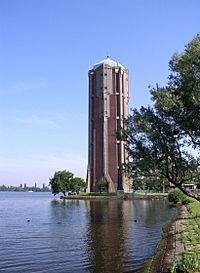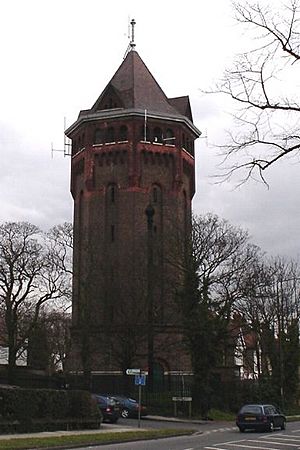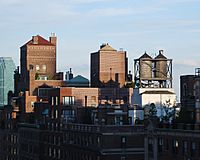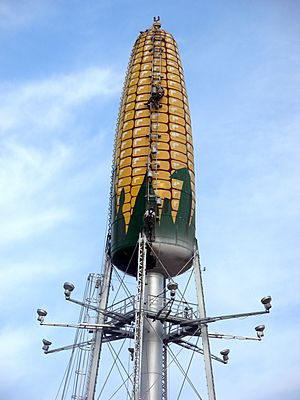Water tower facts for kids
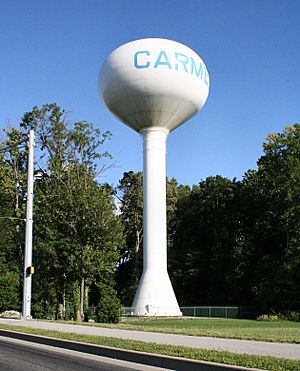
A water tower is a tall building or structure that holds a lot of water. It's usually built high up, often on a hill or with a tall base. Water is pumped up into the tower. Then, gravity helps push the stored water out through pipes to homes and businesses that need it.
Water towers are very useful, especially when there's no electricity. This is because they use gravity to send water out, so they don't need pumps to work all the time. Many water towers were built a long time ago, during the Industrial Revolution. Some of these old towers are now seen as important landmarks or monuments because of their unique design. Some have even been turned into apartments!
In some big cities, like New York City, smaller water towers are built on top of individual buildings. These help supply water to the higher floors.
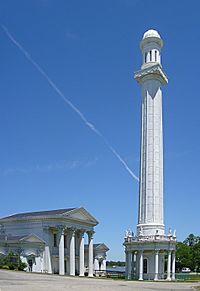
Contents
Building Water Towers
Water towers can be made from different materials. Most often, they are built using steel or strong concrete. Sometimes, wood, fiberglass, or brick are also used. The inside of the tower has a special coating to keep the water safe and clean.
Water towers usually look like a sphere, a cylinder, or an ellipsoid (like a stretched sphere). They are at least 6 metres (20 ft) tall and at least 4 m (13 ft) wide. A typical water tower is about 40 m (130 ft) high.
Why We Need Water Towers
People who use water, whether it's a town, a factory, or just a house, need steady water pressure. This pressure is important for keeping the water supply safe and working well. If there isn't enough water pressure, a few problems can happen:
- Water might not reach the top floors of a building.
- Water might not flow strongly enough from a faucet.
- Without a water tower, dirty groundwater could get sucked into the water pipes if there are leaks. This can make the water unsafe with microorganisms or other harmful things.
Water towers can provide water even when the power goes out. This is because they use the height of the water to create pressure. However, they can't supply water forever without electricity, as a pump is needed to refill them.
Another important reason for water towers is to help with water needs during busy times of the day. The water level in the tower usually drops when many people are using water. Then, a pump fills it back up during the night when fewer people are using water. This constant movement of water also helps stop it from freezing in cold weather.
How Water Towers Work
The height of a water tower creates the pressure for the water system. Sometimes, a pump helps too. The amount of water the reservoir can hold and the size of the pipes control how fast the water flows.
It costs a lot to rely only on pumps to create pressure, especially during times when lots of water is needed. Water towers help reduce the need for pumps to work constantly. This saves electricity and means less expensive pump systems are needed.
When there's a fire, a lot of water is needed very quickly. With a water tower, pumps can be sized for average daily use. The water tower can provide the extra water pressure needed during the day, and the pumps can refill the tower when less water is being used.
Fun Designs and Uses
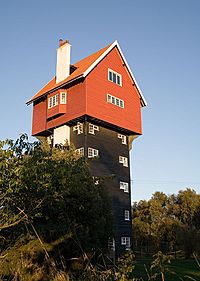
Water towers can be decorated in many ways. Some have fancy brickwork or are covered in ivy. Others are simply painted. Some cities paint their name in big letters on the tower's roof. This helps pilots flying overhead know where they are.
Sometimes, the decoration is funny! For example, Granger, Iowa has two water towers labeled HOT and COLD. The House in the Clouds in Thorpeness, England, was built to look like a house to hide the tower. The lower parts were even used as living space!
The company Sapp Bros. truck stops uses a water tower shaped like a coffee pot as its logo. Many of their locations have real water towers designed this way.
The first "Mushroom" water tower, called Svampen, was built in Örebro, Sweden, in the 1950s. Copies were later built in places like Saudi Arabia and Kuwait.
Many small towns in the United States use their water towers to advertise local tourism, their high school sports teams, or other interesting facts about the town. Since water towers are often the highest point in town, they are also used to hold antennas, public address systems, cameras, and tornado warning sirens.
History of Water Towers
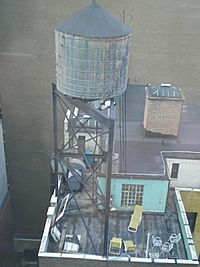
In the 1800s, New York City made a rule that all buildings taller than six stories needed a water tower on the roof. This was to stop pipes from bursting if the water pressure was too high on the lower floors.
The first water tower builders were people who made barrels. They used their skills to build these large wooden tanks. Even today, no special sealant is used to hold the water in. The wooden walls of the tower are held together with cables. When first filled, they might leak a little. But as the wood soaks up the water, it swells, and the gaps close, making the tower waterproof.
These rooftop water towers can hold about 25,000 litres (5,500 imp gal) to 50,000 litres (11,000 imp gal) of water. The water from the top is used for everyday needs. The water at the bottom is kept in case of a fire. When the water level drops, a pump or a public water line refills the tower.
Architects and builders have found different ways to include water towers in their building designs. On many large buildings, water towers are completely hidden behind the building's outer walls. For apartment buildings, the tanks are often covered by rooftop structures. These can be simple boxes or fancy designs that make the building look better. However, many buildings just leave their water towers visible on top of simple frames.
Modern Uses of Water Towers
Water towers are very common in India, where the electricity supply can be unreliable.
In many countries, some old water towers are no longer used for water. Instead, they are seen as important examples of civil engineering. Some have been changed to serve new purposes. For example, the Wieża Ciśnień in Wrocław, Poland, is now used differently.
Historically, steam locomotives used water towers along railroad tracks to refill their water tanks. These towers often fed water to water cranes, which then filled the trains.
Some water towers are also used as observation towers, offering great views. Some even have restaurants inside, like the Goldbergturm in Sindelfingen, Germany, or one of the Kuwait Towers. Water towers are also good places to put antennas for things like local radio, portable radios, or cell phone service.
Unused water towers can even be used to store energy and help create electricity from renewable energy sources. For example, if a tower is connected to a wind turbine, it can store the wind energy and help provide a steady power supply.
Famous Water Towers
Here are some famous water towers:
- In the United States:
- Chicago Water Tower
- Volunteer Park Water Tower in Seattle, Washington
- Warner Bros. Studios Water Tower in Burbank, California (This one is famous from the cartoon Animaniacs!)
- Peachoid next to I-85 in Gaffney, South Carolina (It looks like a giant peach!)
- Earful Tower at Disney's Hollywood Studios
- Florence Y'all Water Tower in Florence, Kentucky
- In the United Kingdom:
- Grimsby Dock Tower in Grimsby
- House in the Clouds in Thorpeness, Suffolk
- Jumbo Water Tower in Colchester, Essex
Images for kids
See also
 In Spanish: Torre de agua para niños
In Spanish: Torre de agua para niños


